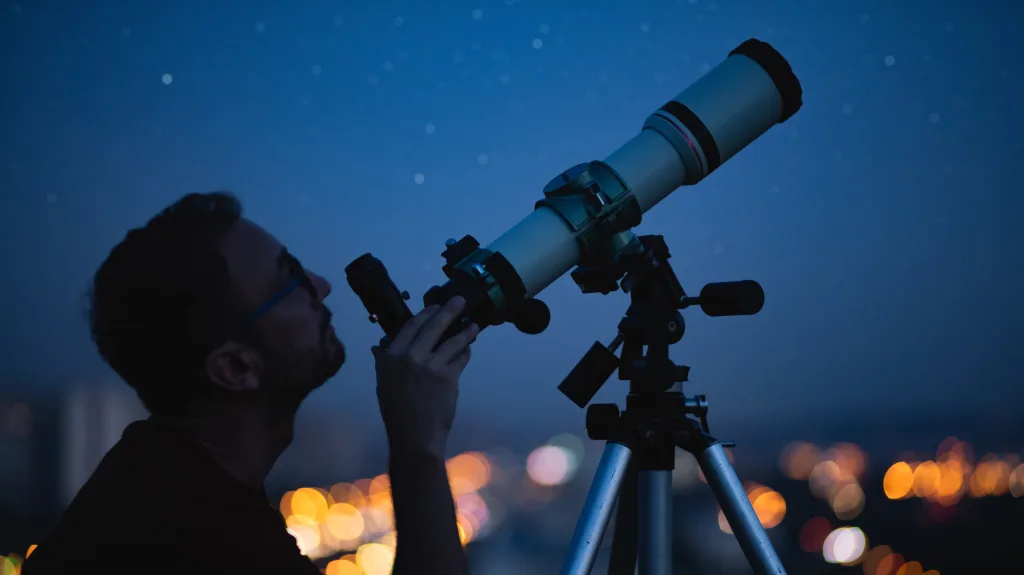
A telescope is an instrument that uses lenses or mirrors to collect and focus light from distant objects in order to magnify them. The three main components of a telescope are the objective lens or mirror, which collects and focuses the light; the eyepiece, through which the user views the image; and the mount, which holds the telescope in place.
There are two types of telescopes: refracting telescopes, which use lenses to gather and focus light, and reflecting telescopes, which use mirrors. Refracting telescopes are further divided into two categories: those with achromatic lenses, which correct for chromatic aberration (an imperfection in the lens that results in an inability to focus all colors to a single point), and those with apochromatic lenses, which correct for both chromatic and spherical aberration (an imperfection in the lens that results in a blurred image). Reflecting telescopes can also be divided into two categories: those with a catadioptric design, which combines a lens and a mirror to gather and focus light, and those with a classical Newtonian design, which uses only mirrors.
The most important factor in choosing a telescope is its aperture, or the diameter of its objective lens or mirror. The larger the aperture, the more light the telescope can gather and the sharper the image will be. However, larger telescopes are also more expensive and bulky, so it is important to choose one that is appropriate for your needs.
How to choose the right telescope for your needs?
When choosing a telescope, the first thing you need to consider is what you want to use it for. Are you interested in viewing planets and stars, or do you want to be able to see distant galaxies? If you only plan on viewing objects in our solar system, such as the moon and planets, then a small telescope with a low magnification will suffice. However, if you want to be able to see more distant objects, such as galaxies and nebulae, then you will need a larger telescope with a higher magnification.
The next thing you need to consider is the size of the telescope. The larger the telescope, the more light it can gather and the sharper the image will be. However, large telescopes are also more expensive and bulky, so it is important to choose one that is appropriate for your needs. If you only plan on using the telescope occasionally, or if you need to transport it frequently, then a smaller telescope might be a better choice.
Finally, you need to consider the type of telescope. There are two types of telescopes: refracting telescopes, which use lenses to gather and focus light, and reflecting telescopes, which use mirrors. Refracting telescopes are further divided into two categories: those with achromatic lenses, which correct for chromatic aberration (an imperfection in the lens that results in an inability to focus all colors to a single point), and those with apochromatic lenses, which correct for both chromatic and spherical aberration (an imperfection in the lens that results in a blurred image). Reflecting telescopes can also be divided into two categories: those with a catadioptric design, which combines a lens and a mirror to gather and focus light, and those with a classical Newtonian design, which uses only mirrors.
How to set up and use your telescope?
Once you have chosen the right telescope for your needs, it is important to learn how to set it up and use it properly. Setting up a telescope can be a simple or complex process, depending on the type of telescope you have. Refracting telescopes typically require the least amount of setup, while reflecting telescopes often require more time and effort. Catadioptric telescopes usually fall somewhere in between.
Before setting up your telescope, make sure you have all the necessary parts and tools. Most telescopes come with instructions that will help you through the process. If you do not have instructions, or if you are unsure about something, there are many resources available online that can help you. Once you have everything you need, follow these steps to set up your telescope:
1. Choose a level, stable surface on which to set up the telescope. A tripod is typically required for stability.
2. If your telescope came with a finder scope, attach it now.
3. Attach the eyepiece to the telescope.
4. Point the telescope in the general direction you want to view.
5. Use the finder scope to locate an object, then center it in the field of view of the eyepiece.
6. Adjust the focus until the image is clear.
Once you have set up your telescope, you are ready to start observing! Remember to be patient and take your time when adjusting the focus. If the image is not perfectly clear at first, keep trying. With practice, you will get better at using your telescope and will be able to see some incredible things!